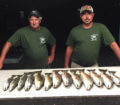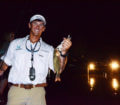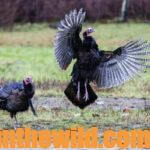Editor’s Note: Captain Colton DeBlieux owns Liquid Force Inshore Charters (https://fishingbooker.com/charters/view/4466) in Orange Beach Alabama. As a youngster, he learned that during the summer months when the weather was hot, water skiers, jet skiers and fishing boats all were very active during the daylight hours. He discovered that he could find and catch more fish, especially speckled trout, redfish and flounder, by dock fishing at night, especially during the hot months of summer and early fall. DeBlieux has a Facebook page at https://www.facebook.com/liquidforceinshorecharters, and his phone number is 251-233-5731.
 As I’ve mentioned earlier, the full moon plays a major role in how many fish we catch on a night fishing trip. One of the best trips I ever had occurred during the full moon of May. We caught eight, good-sized slot redfish, six really-nice trout and two keeper mangrove snapper that night.
As I’ve mentioned earlier, the full moon plays a major role in how many fish we catch on a night fishing trip. One of the best trips I ever had occurred during the full moon of May. We caught eight, good-sized slot redfish, six really-nice trout and two keeper mangrove snapper that night.
Before every trip, I pull a shrimp bed with my 12-foot shrimp net, beginning at about 6:30 pm. I’ll pull the net for about 15-20 minutes to catch the bait I need. This is another secret to success for catching specks and reds at night. You must have fresh, live, active bait. Although we catch a wide variety of baitfish in our net, I only keep the shrimp and the small croakers, because they are the best two baits for speckled trout and redfish. Then I usually pick up my customers at 7:00 pm.
That night you went with us, John, to Old River, we fished some of the lights I normally fish, and we eased up to the trout very quietly. We didn’t start fishing at first. We just wanted to see how much bait was around the lights. We wanted to learn whether speckled trout were coming to the surface and eating the bait – making popping noises – and we wanted to see if any trout were swimming through the lights. Sure enough, this one light met all our criteria for wetting a line and trying to catch some of the fish we were seeing. We lost quite a number of speckled trout, but we caught a good mess of them.
I recently had some anglers who had never had fished with a Kahle hook before. The Kahle hooks we use are circle hooks. If my fishermen come from a background of fishing in fresh water, they’ll have a tendency to try and set the hook hard when they get bites. However, the secret to fishing the circle hook productively is to wait on the trout or the redfish to eat on the bait a little bit to get it deep in its mouth. Then when you set the hook, the hook will roll over on its side and catch the fish in the corner of its mouth. Because my anglers on this night were accustomed to setting their hooks as soon as they felt the strikes, they were pulling the hooks and the bait out of the fishes’ mouths before the fish had the hooks deep enough to allow those Kahle hook to roll over and move to the corners of the mouths of the fish.
Another secret to catching night specks and reds is to keep your rod tip high. When most bass fishermen get ready to set the hook on a plastic bait, they’ll drop their rod tips, take up the slack and then make hard hook sets. But we ask our anglers to keep their rod tips high to:
* have enough force to set the hooks hard when the rod tips are over their heads; and
* set the hooks with short, quick little snaps of their wrists after the fish have chewed on the bait.
 The angler then can fight the big fish and set the hook, and the rod will bend, keeping constant pressure on the fish’s jaw, bringing the fish to the surface and making the fish easier to land.
The angler then can fight the big fish and set the hook, and the rod will bend, keeping constant pressure on the fish’s jaw, bringing the fish to the surface and making the fish easier to land.
Redfish are what I call timid biters. You have to give them more time to take the bait before you set the hook than you do with speckled trout. As most anglers know, there are no absolutes in fishing. Sometimes a redfish will hit the bait really hard and set the hook instantly. But, most redfish like to chew the baits some before they get the baits and the hooks deep enough in their mouths to get proper hook sets. I tell my fishermen, “Don’t set the hook the first time you feel the bite. Let the redfish eat on the bait a little bit. Then set the hook.” However, if you come from a bass-fishing background, you instinctively will attempt to set the hook the first time you feel the fish. This problem was the problem one of my anglers was having on this great night of fishing.
We did catch a good number of redfish, and after we had our limit, we continued to catch redfish and release them. I don’t know how many fish we caught that night, but we caught and released way more than we kept.
The trout also were so active on this night that we just fished a straight hook with a monofilament leader attached with a Uni Knot to our braided line. We hooked the shrimp through the horns, and the croakers through their tails. We pitched the baits on spinning tackle upcurrent of the light and let the bait wash though the light into the dark area just past the light. The reason we rig this way is because the shrimp usually will swim close to the surface, and the live croakers have a tendency to swim down toward the bottom. Since we’d seen the trout feeding just under the surface and on the surface, we felt the shrimp should lure those trout to bite.
 Many times the trout feeding on the surface may not be as big as the trout holding close to the bottom. So, because our croakers swam toward the bottom, we were fishing two different segments of the water with two different baits. After we had caught several trout and missed several trout using this technique, we put a tiny split shot 6 inches up the monofilament line to get both the shrimp and the croaker deeper in the water when they passed through the light.
Many times the trout feeding on the surface may not be as big as the trout holding close to the bottom. So, because our croakers swam toward the bottom, we were fishing two different segments of the water with two different baits. After we had caught several trout and missed several trout using this technique, we put a tiny split shot 6 inches up the monofilament line to get both the shrimp and the croaker deeper in the water when they passed through the light.
When we had caught and missed the trout from that spot, about 9:00 pm, we left Old River and went to Bayou St. John. That’s where we started catching our redfish. Historically, we always catch good numbers of reds in this region. At Bayou St. John, we caught fish more often with live croakers than we did with shrimp. Since redfish often feed closer to the bottom, we also added more weight to our lines to get the croakers down deeper, and we caught eight, good, slot-sized redfish.
To learn more about saltwater fishing, check out John E. Phillips’ Kindle eBooks and some print books at https://johninthewild.com/books/#gulf.
Tomorrow: What Makes a Good Fishing Light and a Fun Inshore Family Fishing Trip with Colton DeBlieux
















